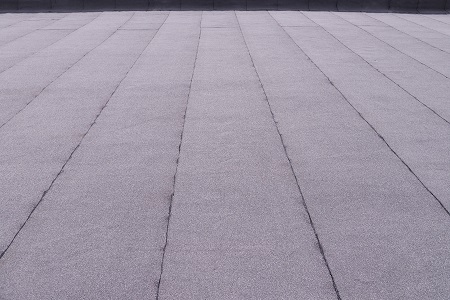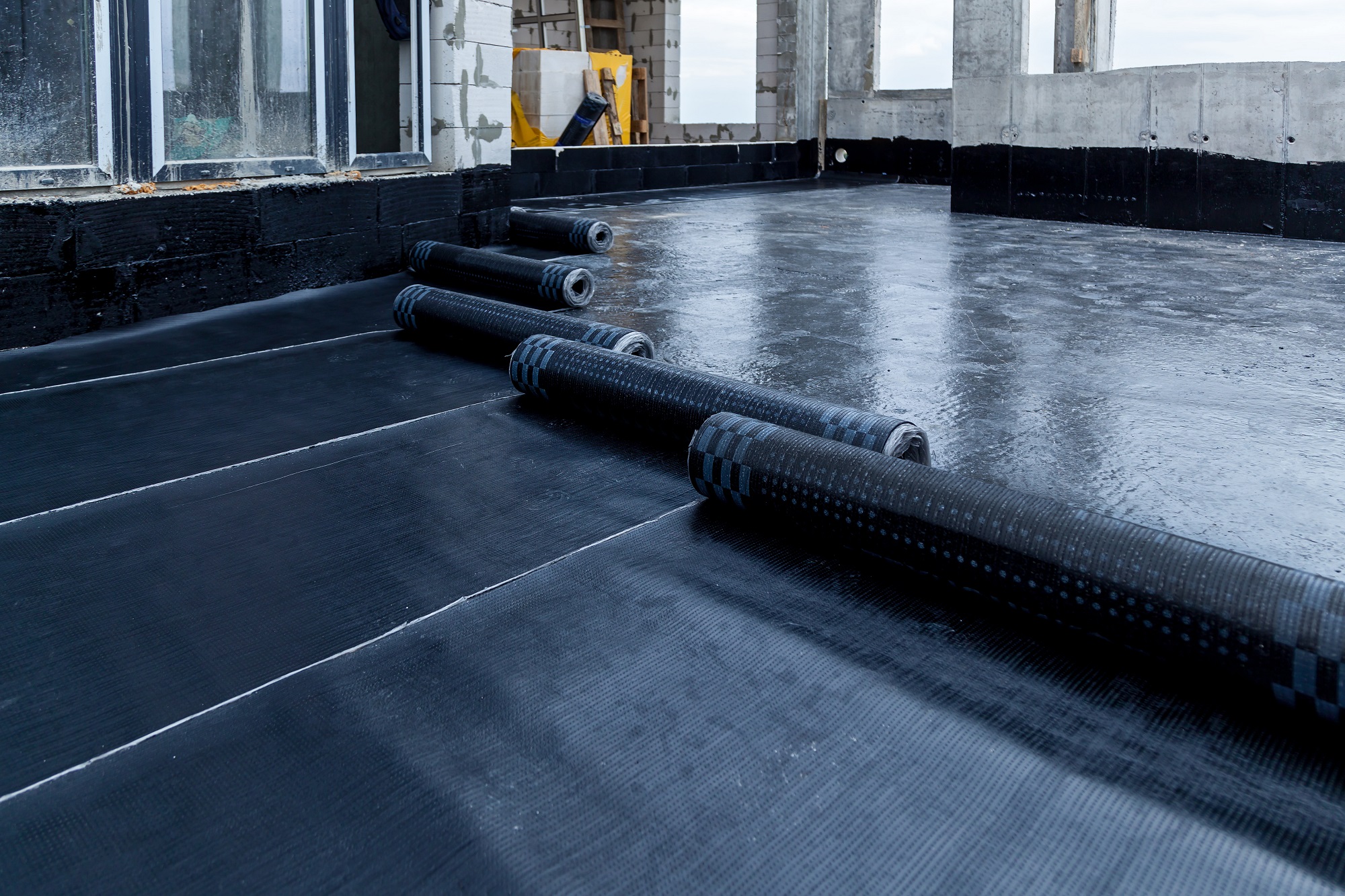You’re about to dive into the world of flat roofing materials. You’ll find practical, in-depth info on EPDM, modified bitumen, built-up, PVC, and TPO roofing.
We’ve got the lowdown on durability, versatility, and selection to help you make the best choice for your property. We’re not just talking theories here – we’re offering real-world solutions.
Let’s explore all your options for flat roof installation!
Understanding the Basics of Flat Roofing
By understanding the basics of flat roofing, you’re taking the first step toward making an informed decision about your property’s roofing needs.
A flat roof isn’t completely flat but has a slight pitch for water drainage. It’s a cost-effective option, thanks to its design simplicity and material efficiency.
But don’t be deceived; you’ve got a variety of materials to choose from. Built-up roofs (BUR) are layered sandwiches of asphalt, fabric, and gravel. Modified bitumen, on the other hand, employs advanced technology to combine the benefits of BUR and single-ply roofing. Then there’s PVC, TPO, and EPDM single-ply roofing, each with its distinct strengths.
The Durability and Benefits of EPDM Roofs
You’re considering EPDM roofing for its exceptional durability and multiple benefits, but you’re also aware of its potential downsides, such as shrinkage and tenting.
This synthetic rubber material is a top contender in the flat roofing market due to its longevity and resistance to extreme weather conditions. It’s easy to install and maintain and can last up to half a century.
However, it’s essential to keep in mind that the elasticity of rubber may lead to shrinkage and tenting, potentially causing leaks and damage. Proper installation and regular maintenance can mitigate these risks.
Ultimately, the choice of roofing material should align with your specific needs, budget, and long-term goals. EPDM roofing stands as a versatile, durable option worth considering.
The Versatility of Modified Bitumen Roofing

In your quest for the ideal roofing material, it’s worth noting the versatility of modified bitumen roofing. This type of roofing material isn’t only durable but also easy to install and maintain. It’s a practical solution for flat or low-slope roofs and can withstand harsh weather conditions with ease.
Here are three key benefits to consider:
1. Durability: Modified bitumen roofs are highly resistant to wear and tear. They can last up to 20 years with proper maintenance.
2. Weather resistance: These roofs can withstand extreme weather conditions, from high temperatures to heavy snowfall.
3. Ease of repair: In case of damage, patches can be easily applied, reducing the overall repair costs.
With these points in mind, you’ll find modified bitumen roofing a reliable choice for your roofing needs.
Built-up Roofing: A Traditional Choice
While modified bitumen roofing is versatile and durable, you’ll find that built-up roofing is a traditional choice that’s stood the test of time and still remains popular. This multilayered solution utilizes alternating layers of bitumen and supporting fabrics, creating a finished membrane that’s resilient to weather, UV rays, and wear and tear.
You’ll appreciate its longevity, often outlasting other flat roofing materials with minimal maintenance. It’s also known for its excellent waterproofing abilities, a critical feature for flat roofs.
It’s not the lightest option, so ensure your building can handle the load. Despite this, its cost-effectiveness, durability, and proven track record make built-up roofing a practical choice for your flat roofing needs.
The Strengths and Weaknesses of PVC Roofing
Often, you’ll be drawn to PVC roofing for its durability and longevity, but it’s important to consider its susceptibility to punctures and shrinkage as well. This type of roofing material is known for its resistance to fire, chemicals, and weather conditions. However, it’s not all rosy.
1. Durability: PVC roofing is strong and can last for around 20 years. However, it can be punctured easily, especially under heavy foot traffic.
2. Shrinkage: Over time, PVC roofs can shrink, leading to exposed roof edges or membrane splitting. Regular inspection and maintenance are essential.
3. Cost: PVC roofing is a bit pricier than other flat roof options. But its fire resistance and durability might make it worth the extra bucks.
Thermoplastic Polyolefin (TPO) Roofing: What You Need to Know
Shifting your focus to Thermoplastic Polyolefin (TPO) roofing, you’ll find it’s a cost-effective and energy-efficient option compared to PVC roofing. TPO is a single-ply roofing material that consists of a thermoplastic polyolefin membrane. This flat roof membrane is composed of three layers: a TPO polymer base, a polyester-reinforced fabric center, and a thermoplastic polyolefin compounded top ply.
What’s more, TPO’s reflective surface deflects sunlight, reducing your cooling costs in the summer. You’ll also appreciate TPO’s flexibility, which allows it to adapt to a building’s movement and setting without becoming damaged. It’s no wonder many property owners are opting for TPO.
However, it’s not a perfect solution. TPO roofs have a shorter lifespan compared to other materials, and they’re not as resistant to punctures.
Selecting the Best Flat Roofing Material for Your Property
Have you considered the advantages and disadvantages of various flat roofing materials for your property yet? Your choice can significantly affect your property’s maintenance, durability, and cost-effectiveness. Here are three options you might consider:
1. Built-Up Roof (BUR): This traditional hot-tar-and-gravel roofing is cost-effective and fire-retardant. However, it’s heavy and might require additional joists.
2. Modified Bitumen: This single-ply roll roof reflects heat, reducing energy costs. It’s easier to install than BUR, but it’s less resistant to punctures.
3. Rubber Membrane (EPDM): This durable material resists damage from sunlight. It’s more expensive but easier to install and repair.
Each material has its strengths and drawbacks. Your decision should balance cost, durability, and maintenance needs according to your property’s specific circumstances.
North American Roofing Will Replace Your Flat Roof with Any of these Materials
Although you’re unsure about which flat roof system to choose, North American Roofing will replace your flat roof with any material you finally decide on. Whether you’re leaning toward the environmental consciousness and flexibility of EPDM, the incredible durability of Modified Bitumen, or the cost-saving aspects of Elastomeric coatings, we have you covered.
If energy efficiency is your aim, consider TPO or PVC materials. These options not only reflect sunlight to keep your building cooler during those scorching summer months, but they also help you reduce cooling costs.
Contact us today to get your commercial building’s roof replaced by our flat roofing contractors.
Other flat roof services we provide:
- Flat Roof Repair Services
- Flat Roof Inspection Services
- Flat Roof Maintenance
- Flat Roof Installation Services
Visit our About Us page for more information about our professional roofing company.

